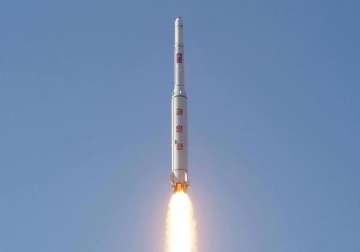North Korea's new satellite flew over Super Bowl site
Tokyo: North Korea's newest satellite passed almost right over the stadium just an hour after it ended. The game in Santa Clara, California, ended at 7:25 p.m. local time.Whatever motives Pyongyang may have about using

Tokyo: North Korea's newest satellite passed almost right over the stadium just an hour after it ended. The game in Santa Clara, California, ended at 7:25 p.m. local time.
Whatever motives Pyongyang may have about using its rocket launches to develop nuclear-tipped long-range missiles, it now has two satellites circling the Earth, according to NORAD, the North American Aerospace Command, which monitors all satellites in orbit.
Both of the Kwangmyongsong, or "Shining Star," satellites complete their orbits in about 94 minutes and based on data released by international organizations tracking them, the new one passed almost right over Levi's Stadium about an hour after the Super Bowl ended.
"It passed almost directly overhead Silicon Valley, which is where I am and where the stadium is," tech watcher Martyn Williams said in an email to The Associated Press."The pass happened at 8:26 p.m., after the game. I would put it down to nothing more than a coincidence, but an interesting one."
North Korea claims Sunday's successful satellite launch was its fourth.
The first two have never been confirmed by anyone else, but experts worldwide agree it got one into orbit in 2012 and NORAD, which is hardly a propaganda mouthpiece for Pyongyang, now has both that and the satellite launched on Sunday on its official satellite list.
Kwangmyongsong 4, the satellite launched Sunday, has the NORAD catalog number 41332 and Kwangmyongsong 3-2, launched in 2012, is 39026. They are described as Earth observation satellites, and weigh about 100 kilograms (220 pounds) apiece.
Their main applications, according to Pyongyang, are monitoring the weather, mapping natural resources and forest distributions and providing data that might help farmers improve their crops.
North Korea's state-run media quoted scientists and researchers at the North's State Hydro-Meteorological Administration as saying they "are delighted at the news" of the launch. Its deputy director, Ryu Pong Chol, reportedly said it will give a big boost to North Korean weather forecasters.
That remains to be seen.
No signals from the previous satellite, which North Korea claimed transmitted the "Song of General Kim Il Sung" and "Song of General Kim Jong Il" after achieving orbit, have ever been confirmed by outside observers.
That might be because it was never stable enough to transmit anything back home. Signals from the new satellite had also yet to be detected.
Amateurs and experts alike are doing their best to listen in around the world, but it is unclear exactly what frequency the satellite is supposed to be using, or what it will be transmitting.
Jonathan McDowell, an astrophysicist working at the Harvard-Smithsonian Center for Astrophysics, said four objects from the 2012 launch are still trackable in their orbits — the satellite itself, the final stage of the Unha-3 rocket that lifted it into space and two small pieces of debris.
"It will stay up for a few more years," McDowell said. "There's no evidence that the spacecraft ever transmitted any signals. If it did work, I suspect it was for only a few hours, if at all."
He said the satellite was in an initial orbit of 498x587 kilometers — figures that denote the object's closest and farthest distance from Earth — similar to the orbit of the satellite launched Sunday.
However, over 3 years, friction with the Earth's outer atmosphere has brought the older one's orbit closer, to 467x529 kilometers. That's still well above the orbit of the International Space Station.
"Perhaps if the new one works they'll actually release Earth images from it," McDowell said. "We'll see."
He also said the Super Bowl coincidence would fit known tracking data.
"I have no idea when the end of the Super Bowl was, not a sports fan," he said. "But KMS-4 did pass over that part of California at 8:27 p.m. PST at an altitude of 480 kilometers. I calculate it was 35 miles west and 300 miles up as it passed overhead heading almost due north."
For the space buffs out there, the orbits of both satellites can be tracked in real time on the website N2YO.com under the names KMS-4 and KMS 3-2.